|
|
History |
Economy
| Government |
Electronic Governance |
Administrative Divisions |
Current- Development Projects |
Police | Demographics |
Noteworthy Attractions |
Sport | Education |
Museums and libraries |
Transport | Media |
Notable People
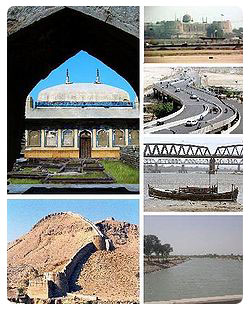 Haidarabad
is the second largest city in the Sindh province of Pakistan. It is the
sixth largest city in the country. Haidarabad
is the second largest city in the Sindh province of Pakistan. It is the
sixth largest city in the country.
The city was founded in 1768 by Mian Ghulam Shah Kalhoro upon the ruins of a
Mauryan fishing village along the bank of
the Indus known as Neroon Kot . Formerly the capital of Sindh, it serves as
the headquarters of the district
of Hyderabad. Before the creation of Pakistan, it was known as the Paris of
India, for its roads used to be washed with
river water.The political boundaries stage the city as a district and the
region has seen major political turmoil. From
the battles fought against the British occupation to the civilian unrest in
the 1980s, the city has lost its glory of past
and much of its cultural and architectural heritage lies in tattered ruins.
Hyderabad is a hot and humid city in the south of the nation and has been a
staging point for literary campaigns particularly
oriented towards the Sindhi language and a birthplace of a few influential
poets and Sufi dervishes. Rich with culture and
tradition, the city is the largest bangle producer in the world and serves
as a transit between the rural and the urban Sindh.
Stationed close to important architectural digs like the pre-Harappan Amri
at 110 km, the region holds extreme importance to
palaeontologists world over. The city is also known for its medical and
educational institutions. It is also home to one of
the oldest universities in the region, the University of Sindh.
Search Hyderabad on
Satellite Map
Places of Interest
| Hotels |
Eating &
Dining | Parks &
Gardens |
Educational Institutes |
Sport Centers |
Banks |
Police Stations |
Shopping /Trade
History
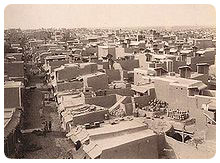 Hyderabad
is a city built on three hillocks cascading over each other. Mian Ghulam
Shah Kalhoro of the Kalhora Dynasty founded the city in 1768 over the ruins
of Neroon Kot (meaning the place of Neroon), a small fishing village on the
banks of River Indus named after its ruler Neroon. A formal concept of the
city was laid out by his son, Sarfraz Khan in 1782. When the foundations
were laid, the city obtained the nickname Heart of the Mehran as the ruler
Mian Ghulam Shah himself was said to have fallen in love with the city. In
1768 he ordered a fort to be built on one of the three hills of Hyderabad to
house and defend his people. The fort was built using fire-baked bricks
giving it the name Pacco Qillo (Sindhi: پڪو قلعو) meaning the strong fort. Hyderabad
is a city built on three hillocks cascading over each other. Mian Ghulam
Shah Kalhoro of the Kalhora Dynasty founded the city in 1768 over the ruins
of Neroon Kot (meaning the place of Neroon), a small fishing village on the
banks of River Indus named after its ruler Neroon. A formal concept of the
city was laid out by his son, Sarfraz Khan in 1782. When the foundations
were laid, the city obtained the nickname Heart of the Mehran as the ruler
Mian Ghulam Shah himself was said to have fallen in love with the city. In
1768 he ordered a fort to be built on one of the three hills of Hyderabad to
house and defend his people. The fort was built using fire-baked bricks
giving it the name Pacco Qillo (Sindhi: پڪو قلعو) meaning the strong fort.
After the death of the great Kalhoro, started the Talpur dynasty. Mir Fateh
Ali Khan Talpur left his capital Khudabad, the Land of God and made
Hyderabad his capital in 1789. He made the Pacco Qillo his residence and
also held his courts there. Mir Fateh Ali Khan Talpur along with his three
other brothers were responsible for the affairs that persisted in the city
of Hyderabad in the years of their rule. The four were called char yar,
Sindhi for the four friends.
The Baloch Talpur rule lasted almost over 50 years and in 1843, Talpurs
faced a greater threat, the invasion of expanding British colonial empire.
The British wanted to annex Sindh due to their strategic interests in the
Punjab region and Afghanistan. The Talpur Amir signed an peace agreement
that gave significant concessions to the British. After signing this peace
agreement Amir Talpur demobised his volunteer army. The British General
Napier also started to march his army back towards Bombay. When the General
Napier heard that the Talpur Amir has demobilised his Baloch army he turned
back his army and again threatened Hyderabad. The peace agreement with
Talpur Amir was of no consequence compared to the strategic interests of the
British colonial empire. The British came face-to-face with the Talpurs at
the Battle of Miani on 17 February 1843. General Napier was firmly
determined in conquering Sindh and plundering Hyderabad. The battle ended on
24 March 1843 when the Talpur Amirs lost and the city came into the hands of
the British. The Amirs of Hyderabad suffered great loss, their Fort was
plundered, thousands were killed and Amirs themselves were exiled to
Rangoon, Burma - never to see Sindh again. The British made the city part of
the Bombay Presidency of British colonia empire.
At the time of independence of Pakistan in 1947, many Muslims in India faced
pograms and genocide and they escaped to Pakistan and many settled in the
city of Hyderabad. These refugee Muslim lost everything in India and were
settled in refugee camps. This hostility translated into communal tension in
Hyderabad between Muslim refugees and local Hindus. When the independence
occurred, Hindus expected to remain in Sindh. However were forced to flee
due to communal violence, leaving behind everything. Sindhi Hindus had
expected to return to their Sindh, once the violence settled but it was not
possible.
The massive migration of Muslim refugees escaping pograms and genocide in
India raised the population levels of the city to extremes and the
Government proposed the creation of two new suburban towns, Latifabad and
Qasimabad. The 1980s saw a black period in the history of Hyderabad as riots
erupted in the city between the Sindhis and the Muhajirs. Chaos led to
bloodshed and as a result Sindhis retreated to settlements in Qasimabad and
the Muhajirs settled down in Latifabad. The city being scarred thenceforth
is ethnically divided to date.
Find more about
History of Pakistan
Go To Top
Economy
Hyderabad is an important
commercial centre where industries include textiles, sugar, cement,
manufacturing of glass, soap, ice, paper, pottery, plastics, tanneries,
hosiery mills and film. There are hide tanneries and sawmills. Handicraft
industries, including silver and gold work, lacquer ware, ornamented silks,
and embroidered leather saddles, are also well established. Hyderabad
produces almost all of the ornamental glass bangles in Pakistan. Hyderabad
is a major commercial centre for the agricultural produce of the surrounding
area, including millet, rice, wheat, cotton, and fruit.
Pakistani government recently discovered a large gas deposit in hydrabad
which has not been used prperly till this day
Find more about
Worldwide
Business & Economy
Go To Top
Government
The city of Hyderabad is where the district headquarters are located and the
district government is seated. The current nazim for the Hyderabad district
is Kanwar Naveed Jamil. Since his election as the official mayor, he had
been successful in initiating major development projects throughout the
city. The primary concerns that he had targeted as a result of these
development efforts in 2007 were that of traffic congestion, supply of fresh
drinking water, sewerage and garbage management, medical aid and schools for
the poor.The naib nazim is Zafar Ali Rajput.
Go To Top
Electronic Governance
The government of the city does not yet support fully functional
e-governance and has no website but the District Government of Hyderabad
liberally uses the television as a mode of communication with the people of
the city instructing them on public issues and awareness about projects
under way. As of 2008, the district Hyderabad enabled its e-governance
platform to support people via the Internet and other new media platforms.
Go To Top
Administrative Divisions
Before the government of Zulfiqar Ali Bhutto, the District Hyderabad
included in the present-day District of Badin, Matairi, Tando Allahyar and
Tando Mohammad Khan. Then after about 30 years the District Hyderabad was
again subdivided into four talukhas of its own. These four districts are the
smallest districts of the Sindh province.
Hyderabad City Taluka
Hyderabad Taluka (rural)
Latifabad
Qasimabad
Go To Top
Current Development Projects
In light of the above development criteria, the Hyderabad Government has
constructed flyover in Latifabad Unit # 7 to relieve the traffic congestion
on the GCD road. Due to the success of this project, five more flyover
projects has been started.
Two filter plants to filter fresh water have been installed costing about Rs.
80,000,000. Their inclusion in the water system would ensure continuous
supply of clean drinking water. The filter plants at the time of writing are
90% complete and would be functional by mid-2008.
Go To Top
Police
While 19 police stations along with three police stations with own web
development team Like 1) Police station Cantonment(www.pscant.4t.com)
.2)Police station GOR(www.psgor.4t.com). 3) Police station Makki
shah(www.psmakkishah.4t.com)are valuable addition to district police
Hyderabad. Two new police stations 1)PS Air Port 2)PS Bhudhani have been
formed to combat crime
Find more about
Police
Go To Top
Demographics
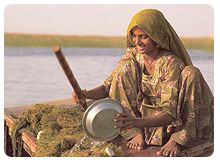 Hyderabad
is noteworthy in Sindh and Pakistan generally for its relative tolerance
towards religious and ethnic affairs. During the partition 1947 a large
number of Muslim refugees migrated to Hyderabad. Nowadays, native Sindhis
and non-Sindhi speaking Sindhis live in harmony after a brief history of
conflict. A large influx of Pakhtuns and Punjabis were attracted to
Hyderabad after the Indus treaty settlement. Most Punjabis mixed with the
local population however most Pakhtuns are distinct and separately living
near the railway station and its vicinity. The city therefore has ben
regarded to have a sizeable diaspora. Hyderabad
is noteworthy in Sindh and Pakistan generally for its relative tolerance
towards religious and ethnic affairs. During the partition 1947 a large
number of Muslim refugees migrated to Hyderabad. Nowadays, native Sindhis
and non-Sindhi speaking Sindhis live in harmony after a brief history of
conflict. A large influx of Pakhtuns and Punjabis were attracted to
Hyderabad after the Indus treaty settlement. Most Punjabis mixed with the
local population however most Pakhtuns are distinct and separately living
near the railway station and its vicinity. The city therefore has ben
regarded to have a sizeable diaspora.
Hindus account for the largest minority forming 10% of the total population
of the city. While Christians account for just 2% of the total population,
Hyderabad is the seat of a Diocese of the Church of Pakistan and has five
churches and a cathedral.
Despite its strategic location and thrifty people the city is under the
shadow of Karachi and yet to make its mark economically. One reason for this
is the artificial factional and sectarian isolation imposed after the riots
of late 1980s and early 1990s which cleft the urban population.
Go To Top
Noteworthy Attractions
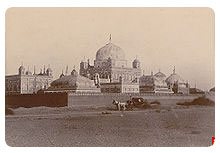 Amri
(Pre-Harappa) – an archaeological site dating back to 3600 BC, 110 km from
the city, is the remains of a pre-Harrapan fortified town. Amri
(Pre-Harappa) – an archaeological site dating back to 3600 BC, 110 km from
the city, is the remains of a pre-Harrapan fortified town.
Pacco Qilo (Hyderabad Fort) and the Kachha Qila (Weak Fort) – A fort built
by the Talpur dynasty to keep out invaders during the 17th century.
The Tombs of Talpur Mirs (Cubbas) in Hirabad are of the former rulers of
Sindh who were defeated by the British in the famous battle of Miani.
Agham Kot – an archaeological site containing the reminence and tombs of an
ancient empire.
Rani Bagh – formerly a zoo named for Queen Victoria of England (The zoo was
founded by the British colonial local administration, Rani means "Queen" in
urdu), has been renovated and has become a very beautiful park with exotic
animals such as lions, zebras, different species of birds as well as horses.
Hussainabad Park – A central cark with a man-made lake, home to various bird
life.
Mustafa Park – A newly inaugrated park at Noorani Basti with life scale
animal models.
Ranikot Fort – One of the largest forts in the world according to
circumference. Located 90 km from the city.
Sindh Museum – The museum features the history and heritage of the Sindh and
Indus Valley Civilization. Items from various ruling periods of Sindh,
including Sama, Soomra, Kalhora and Talpur periods can be found at the
museum.
Institute of Sindhology Museum – It has dioramas which display many aspects
of Sindhi history, heritage, music and culture. Some very interesting
dioramas depict the lifestyles of the desert tribes of
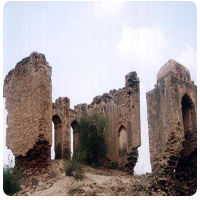 Thar
and Kohistan. Based at the University of Sindh. Thar
and Kohistan. Based at the University of Sindh.
Resham Ghiti, Chhotki Ghiti and Shahi Bazaar – Are some of Hyderabad's
oldest markets to find souvenirs, arts and crafts, embroidery and jewellery
of Sindhi heritage.
The River Indus – The largest river that flows within Pakistan flows
alongside the city of Hyderabad. It is known to have some of the finest
fishing spots in Pakistan.
Navalrai Market Clock Tower – Built in 1990. A tall strcuture that is
associated with Hyderabad's skyline.
The Palace of Prince Mir Hassan Ali Khan Talpur the son of the last ruler of
Hyderabad His Highness Mir Naseer Khan Talpur. This Palace is located in
Tando of Talpur Mirs in Latifabad.
New Hyderabad City – a well known private development area in the outskirts
of Hyderabad, best known for its famous 12-acre (49,000 m2) park, Lake View
Park, which features a man made lake and beautiful gardens. The park has
become a recreational spot for the local families, specially on national
holidays.
Go To Top
Sport
Hyderabad has a cricket stadium called the Niaz Stadium, with a seating
capacity of 25,000 known for the first ever hat-trick taken by a bowler in a
one-day international (ODI) match in 1982. Many cricket test matches were
played at Niaz Stadium. Nowadays many visiting test playing countries refuse
to play in Hyderabad because of lack of 5 star hotel. Hyderabad also has a
hockey stadium. There is another stadium in Latifabad called Board Stadium
mostly catering to school sports under the supervision of BISE (Board of
Intermediate and Secondary Education) Hyderabad
Satellite View of Sports centers
Go To Top
Education
Satellite View of Educational Institutes
The pre independence days were horrible educationwise for Muslims of
Hyderabad. As there was only one school where Muslim students could study
was Noor Mohammad High School. Which was founded by famous Sindhi
educationist Noor Mohammad. All other schools admitted only Hindu students.
The city being a gateway between the rural Sindh and the Greater Sindh,
attracts students from the lesser developed regions of Sindh. Hyderabad has
a huge number of schools, colleges and Universities.
A nerve center of Sindh nationalist and literary movements, the city now
have better education facilities and new universities, colleges and school
established. At one time a hub of economic, educational and cultural
activities, a breeding ground of academicians, philanthropists, writers,
lawyers, politicians, journalists, actors and actresses, Hyderabad also had
its industrialists, trade unionists, political activists, bureaucrats,
bankers and diplomats who made a significant contribution to sub-continental
society. But this gracious city now seems to be slowly dying, although it
still produces over a couple of dozen major and minor newspapers in both
Sindhi and Urdu
Go To Top
Universities and colleges
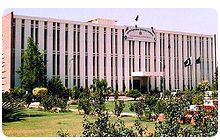 The
University of Sindh is the dominant player in educational reforms since its
inception in 1947. The University of Sindh,the second oldest university of
the country, was constituted under the University of Sindh Act. No. XVII of
1947 passed by the Legislative Assembly of Sindh. It was founded in Karachi
and relocated to Hyderabad in 1951, only because the city was re-enacted as
the capital of the province of Sindh. It has 32 colleges affiliated with it.
Other universities like the Mehran University of Engineering and Technology
and Liaquat University of Medical and Health Sciences serve the interests of
a wide range of other specialized subjects. Whilst people prefer to go to
this technological and medical universities in the city, universities like
the Sindh Agriculture University in Tando Jam focusing primarily on
agriculture and horticulture, are highly preferred as well. Other
universities in the private sector include University of East and Isra
University. The
University of Sindh is the dominant player in educational reforms since its
inception in 1947. The University of Sindh,the second oldest university of
the country, was constituted under the University of Sindh Act. No. XVII of
1947 passed by the Legislative Assembly of Sindh. It was founded in Karachi
and relocated to Hyderabad in 1951, only because the city was re-enacted as
the capital of the province of Sindh. It has 32 colleges affiliated with it.
Other universities like the Mehran University of Engineering and Technology
and Liaquat University of Medical and Health Sciences serve the interests of
a wide range of other specialized subjects. Whilst people prefer to go to
this technological and medical universities in the city, universities like
the Sindh Agriculture University in Tando Jam focusing primarily on
agriculture and horticulture, are highly preferred as well. Other
universities in the private sector include University of East and Isra
University.
Most of the colleges are affiliated with the universities above but some
enjoy repute built of time like the oldest being the Government Degree
College now renamed Government College of Technology with its high- and
secondary-school affiliations with the Government High School who celebrate
alumni like Mirza Kalich Beg & best Collage in Hyderabad is Muslim Science
Collage at Tower Market area.
Find more about
Worldwide Education
Go To Top
Museums and libraries
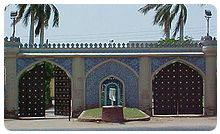 Hyderabad
is home to a few museums that store the cultural heritage of this land of
religious and ethnic diversity. The Institute of Sindhology Museum and the
Sindh Museum are a haven for Sindhi enthusiasts in ethnological contexts.
Sindh Museum also hosts archæological treasures from Amri. Whilst there are
a few libraries in the city, most of them are in a sad state. There is a
children's library opposite Lady Duffrin Hospital on Station road, very few
people know about its existence. Work is going on Moullana Hasrat Mohani
library near pukka kila main gate in the homestead hall building. Allama
Daudpota Library near Sindh Museum in Qasimabad stores literary work dating
back to the earliest Sindhi text. Hyderabad
is home to a few museums that store the cultural heritage of this land of
religious and ethnic diversity. The Institute of Sindhology Museum and the
Sindh Museum are a haven for Sindhi enthusiasts in ethnological contexts.
Sindh Museum also hosts archæological treasures from Amri. Whilst there are
a few libraries in the city, most of them are in a sad state. There is a
children's library opposite Lady Duffrin Hospital on Station road, very few
people know about its existence. Work is going on Moullana Hasrat Mohani
library near pukka kila main gate in the homestead hall building. Allama
Daudpota Library near Sindh Museum in Qasimabad stores literary work dating
back to the earliest Sindhi text.
Go To Top
Transport
Serving as a socio-economic crossroad to the lesser developed cities and
towns in Sindh and linking and networking them with the bigger towns and
cities in the nation, Hyderabad holds importance as a vital transportation
link via every service. It can be reached by every mean of transportation,
be it air, land, water or rail.
 The
city has a modestly good airport. The operation was stopped for some years
but the airport has started operating again from late 2008. There are 2
flights every week from Hyderabad. Currently the national flag carrier,
Pakistan International Airlines, operates prop aircraft into the city with
flights to other cities within PakistanHyderabad has a decent road network,
but most of the roads are being redone by the National Highway Authority.
Hyderabad is deemed the most important milestone on the National Highway
which passes through the city. The highway divides into Route N5 going
southwest and M9 going north while it forks into the KLP (Karachi, Lahore,
Peshawar, Faislabad) Road and the Hala Road. Over the years, the M9 has had
massive construction work to include six lanes across its 136 km span being
the most used highway in Pakistan while the N5 has two lanes to cater to its
lesser traffic needs. However, the public has stressed to improve the
conditions of the roads within Hyderabad. The
city has a modestly good airport. The operation was stopped for some years
but the airport has started operating again from late 2008. There are 2
flights every week from Hyderabad. Currently the national flag carrier,
Pakistan International Airlines, operates prop aircraft into the city with
flights to other cities within PakistanHyderabad has a decent road network,
but most of the roads are being redone by the National Highway Authority.
Hyderabad is deemed the most important milestone on the National Highway
which passes through the city. The highway divides into Route N5 going
southwest and M9 going north while it forks into the KLP (Karachi, Lahore,
Peshawar, Faislabad) Road and the Hala Road. Over the years, the M9 has had
massive construction work to include six lanes across its 136 km span being
the most used highway in Pakistan while the N5 has two lanes to cater to its
lesser traffic needs. However, the public has stressed to improve the
conditions of the roads within Hyderabad.
There are seven large bus terminals within the city. Some of the most
busiest are the Badin Bus Stop near SITE, Tando Bago Coach Stop,
Jacobabad-Larkana Bus Stop at Pathan Colony, Nawab Shah Bus Stand at Halla
Nakka, Sanghar Coach Stop near Civil Hospital, Karachi Bus Stand near Qasim
Chowk and Sammi Daewoo Bus Service To Karachi at Auto-Bhan Road and
Latifabad U7.
 Hyderabad
has a rich rail history. From the starting days of the Scinde Railways to
the purchase of the private railway company by the North-Western Railway now
Pakistan Railways, Hyderabad has been a major junction on the rail-line,
where railway lines proceed in at least three directions: northwards
(up-country), southwards (down-country) and eastwards. The railway station
is called the Hyderabad Junction. It was built under the British rule in
1890. The city with increasing need of transport facility is still facing a
real trouble with respect to the rail transport. One full fledged while two
little stations in detha and tando jam are not satisfying the demands for
rail travel. Hyderabad
has a rich rail history. From the starting days of the Scinde Railways to
the purchase of the private railway company by the North-Western Railway now
Pakistan Railways, Hyderabad has been a major junction on the rail-line,
where railway lines proceed in at least three directions: northwards
(up-country), southwards (down-country) and eastwards. The railway station
is called the Hyderabad Junction. It was built under the British rule in
1890. The city with increasing need of transport facility is still facing a
real trouble with respect to the rail transport. One full fledged while two
little stations in detha and tando jam are not satisfying the demands for
rail travel.
With the city at the banks of the Indus River, the fishermen tend to use
riverboats to fish and travel across the waters. Riverboats are not
accessible to general public but local fishermen, in attempts of making
money for their daily ration, sail people aboard their fishing ferries at
Al-manzar, a restaurant at the banks of the Indus.
Go To Top
Media
Literature
As tradition goes, Sindh had always been a hub for Sufi poets. With a
foothold on strong educational foundations, the city of Hyderabad was made
into a refuge for thriving literary advocates. Of the few, Mirza Kalich Beg
received education from the Government High School, Hyderabad and carried
the banner of Sindhi literature across borders. Modern novelists, writers,
columnists and researchers like Musharraf Ali Farooqi, Dr. Syed Mehboob and
Ghulam Mustafa Khan also hail from Hyderabad.
Hyderabad has served many Sindhi literary campaigns throughout the history
of Pakistan as is evident from the daily newspapers and periodicals that are
published in the city. A few worth mention are the dailies Kawish, Ibrat,
and Daily Sindh
Radio and Television
With the inauguration of a new broadcasting house at Karachi in 1950, it was
possible to lay the foundations for the Hyderabad radio station in 1951. The
initial broadcast was made capable using 1 kW medium-wave transmitter. With
the first successful transmissions on the FM 100 bandwidth in Karachi,
Lahore and Islamabad in October 1998, the Government decided on opening
transmissions to other cities where Radio Pakistan had found success. This
made available the FM 101 bandwidth transmissions to Hyderabad and other
cities in Sindh.
A relief from the regular broadcasts in other cities, entertainment content
on the Hyderabad radio gave birth to many a star whose names became an
attribute to Hyderabad's richer media content. Among them were actor Shafi
Mohammad, a young man who had recently finished his postgraduate degree from
the University of Sindh. Such fresh and young talent became a trademark to
entertainment in Hyderabad.
Whilst radio was gaining popularity, bulky television screens showed the
broadcast of Neil Armstrong setting foot on the moon. Pakistan Television
had only had half-a-decade broadcast success from 1963 to 1969 that people
in the radio entertainment business felt destined to make a mark on the
television circuits. Prominent radio personalities from the Hyderabad radio
station like Shafi Muhammad Shah and Mohammad Ali left the airwaves to hone
their acting skills on the television.Television shows and content enriched
with the inclusion of Hyderabadi names however PTV never opened a
broadcasting station in Hyderabad.
While the year 2005 saw new FM regular stations set up at Gawadar, Mianwali,
Sargodha, Kohat, Bannu and Mithi, private radio channels began airing in and
around Hyderabad. Of late, stations like Sachal FM 105 and some others have
gained popularity. But the unavailability of an up-to-date news and current
affairs platform renders the services of such stations of not much value to
the masses but nonetheless appealing to youngsters.
As the Pakistan Electronic Media Regulatory Authority (abbreviated as PEMRA)
gave licenses to private radio channels, so were television channels owned
privately given a right to broadcast from the year 2002,and Daily Kawish, a
prominent Sindhi newspaper published from Hyderabad opened a one-of-its-kind
private Sindhi channel Kawish Television Network. Many followed in its path
namely Sindh TV, Dhoom TV and Kashish TV premièring Sindhi content.
Find more about
Media & News in Pakistan
Go To Top
Notable People
Dr. Muhammad Ismail Nami Homoeopathic doctor, social worker, founder of
Khalid Memorial Welfare Society and Sindh Homoeopathic Medical College
Hyderabad located near Guru Nagar and Pakka Kila, was President of National
Council for Homoeopathy.
Choudry Mohammad Sadiq (1900–1975) was born in Batala, District Gurdaspur,
Graduated from Islamia College, Lahore and obtained his law degree in 1928.
He was an eminent politician and remained a Muslim Leaguer before and after
independence. Settled in Sindh in 1934. First bought land near Tando Ghulam
Ali and then near Hyderabad and moved to Hyderabad in 1940. Founded Sindh
Chamber of Agriculture in late 1960s. A famous housing scheme of Hyderabad (Sadiq
Livina) is named after him.
Syed Qamar Zaman Shah was born 12 September 1933, did B.A. (Hons), 1957,
L.L.B. 1959. He is the nephew and son-in-law of Late Syed Miran Mohammad
Shah. He remained Senator during early 1970s. He is President of Sindh
Chamber of Agriculture for the last many years. His eldest son Syed Naveed
Qamar is a Federal Minster these days.
Syed Miran Mohammad Shah was speaker of Sindh legislative Assembly, Minister
Sindh Government, Ambassador of Pakistan in Spain.
Dr. Ghulam Mustafa Khan, born 1912, Ph.D., D.Litt, SI, was a researcher,
critic, linguist, author, scholar of Urdu literature & linguistics,
educationist, religious & spiritual leader of Naqshbandi Mujadidiah order.
Dr. Sahib was a very pious person and guided many people on this order.
Pir Syed MoinUddin Khamis, born in 1910, A Retired Excise and Custom deputy
collector, and got famous because of descendant of Great Khawaja Garib Nawaz.
He was a great spiritual and religious leader of chishti silsila. He died on
22 Rajab 8 Jan 1994 and was buried in the area of Sarfraz Shaheed Kulhoro
Tomb.
Prof:Syed Qavi Ahmed,renewed educationist, S.K.Rahim, Founder of City
College,Hyderabad.
Go To Top
|




 Haidarabad
is the second largest city in the Sindh province of Pakistan. It is the
sixth largest city in the country.
Haidarabad
is the second largest city in the Sindh province of Pakistan. It is the
sixth largest city in the country.  Hyderabad
is a city built on three hillocks cascading over each other. Mian Ghulam
Shah Kalhoro of the Kalhora Dynasty founded the city in 1768 over the ruins
of Neroon Kot (meaning the place of Neroon), a small fishing village on the
banks of River Indus named after its ruler Neroon. A formal concept of the
city was laid out by his son, Sarfraz Khan in 1782. When the foundations
were laid, the city obtained the nickname Heart of the Mehran as the ruler
Mian Ghulam Shah himself was said to have fallen in love with the city. In
1768 he ordered a fort to be built on one of the three hills of Hyderabad to
house and defend his people. The fort was built using fire-baked bricks
giving it the name Pacco Qillo (Sindhi: پڪو قلعو) meaning the strong fort.
Hyderabad
is a city built on three hillocks cascading over each other. Mian Ghulam
Shah Kalhoro of the Kalhora Dynasty founded the city in 1768 over the ruins
of Neroon Kot (meaning the place of Neroon), a small fishing village on the
banks of River Indus named after its ruler Neroon. A formal concept of the
city was laid out by his son, Sarfraz Khan in 1782. When the foundations
were laid, the city obtained the nickname Heart of the Mehran as the ruler
Mian Ghulam Shah himself was said to have fallen in love with the city. In
1768 he ordered a fort to be built on one of the three hills of Hyderabad to
house and defend his people. The fort was built using fire-baked bricks
giving it the name Pacco Qillo (Sindhi: پڪو قلعو) meaning the strong fort. Hyderabad
is noteworthy in Sindh and Pakistan generally for its relative tolerance
towards religious and ethnic affairs. During the partition 1947 a large
number of Muslim refugees migrated to Hyderabad. Nowadays, native Sindhis
and non-Sindhi speaking Sindhis live in harmony after a brief history of
conflict. A large influx of Pakhtuns and Punjabis were attracted to
Hyderabad after the Indus treaty settlement. Most Punjabis mixed with the
local population however most Pakhtuns are distinct and separately living
near the railway station and its vicinity. The city therefore has ben
regarded to have a sizeable diaspora.
Hyderabad
is noteworthy in Sindh and Pakistan generally for its relative tolerance
towards religious and ethnic affairs. During the partition 1947 a large
number of Muslim refugees migrated to Hyderabad. Nowadays, native Sindhis
and non-Sindhi speaking Sindhis live in harmony after a brief history of
conflict. A large influx of Pakhtuns and Punjabis were attracted to
Hyderabad after the Indus treaty settlement. Most Punjabis mixed with the
local population however most Pakhtuns are distinct and separately living
near the railway station and its vicinity. The city therefore has ben
regarded to have a sizeable diaspora. Amri
(Pre-Harappa) – an archaeological site dating back to 3600 BC, 110 km from
the city, is the remains of a pre-Harrapan fortified town.
Amri
(Pre-Harappa) – an archaeological site dating back to 3600 BC, 110 km from
the city, is the remains of a pre-Harrapan fortified town.  Thar
and Kohistan. Based at the University of Sindh.
Thar
and Kohistan. Based at the University of Sindh.  The
University of Sindh is the dominant player in educational reforms since its
inception in 1947. The University of Sindh,the second oldest university of
the country, was constituted under the University of Sindh Act. No. XVII of
1947 passed by the Legislative Assembly of Sindh. It was founded in Karachi
and relocated to Hyderabad in 1951, only because the city was re-enacted as
the capital of the province of Sindh. It has 32 colleges affiliated with it.
Other universities like the Mehran University of Engineering and Technology
and Liaquat University of Medical and Health Sciences serve the interests of
a wide range of other specialized subjects. Whilst people prefer to go to
this technological and medical universities in the city, universities like
the Sindh Agriculture University in Tando Jam focusing primarily on
agriculture and horticulture, are highly preferred as well. Other
universities in the private sector include University of East and Isra
University.
The
University of Sindh is the dominant player in educational reforms since its
inception in 1947. The University of Sindh,the second oldest university of
the country, was constituted under the University of Sindh Act. No. XVII of
1947 passed by the Legislative Assembly of Sindh. It was founded in Karachi
and relocated to Hyderabad in 1951, only because the city was re-enacted as
the capital of the province of Sindh. It has 32 colleges affiliated with it.
Other universities like the Mehran University of Engineering and Technology
and Liaquat University of Medical and Health Sciences serve the interests of
a wide range of other specialized subjects. Whilst people prefer to go to
this technological and medical universities in the city, universities like
the Sindh Agriculture University in Tando Jam focusing primarily on
agriculture and horticulture, are highly preferred as well. Other
universities in the private sector include University of East and Isra
University. Hyderabad
is home to a few museums that store the cultural heritage of this land of
religious and ethnic diversity. The Institute of Sindhology Museum and the
Sindh Museum are a haven for Sindhi enthusiasts in ethnological contexts.
Sindh Museum also hosts archæological treasures from Amri. Whilst there are
a few libraries in the city, most of them are in a sad state. There is a
children's library opposite Lady Duffrin Hospital on Station road, very few
people know about its existence. Work is going on Moullana Hasrat Mohani
library near pukka kila main gate in the homestead hall building. Allama
Daudpota Library near Sindh Museum in Qasimabad stores literary work dating
back to the earliest Sindhi text.
Hyderabad
is home to a few museums that store the cultural heritage of this land of
religious and ethnic diversity. The Institute of Sindhology Museum and the
Sindh Museum are a haven for Sindhi enthusiasts in ethnological contexts.
Sindh Museum also hosts archæological treasures from Amri. Whilst there are
a few libraries in the city, most of them are in a sad state. There is a
children's library opposite Lady Duffrin Hospital on Station road, very few
people know about its existence. Work is going on Moullana Hasrat Mohani
library near pukka kila main gate in the homestead hall building. Allama
Daudpota Library near Sindh Museum in Qasimabad stores literary work dating
back to the earliest Sindhi text. The
city has a modestly good airport. The operation was stopped for some years
but the airport has started operating again from late 2008. There are 2
flights every week from Hyderabad. Currently the national flag carrier,
Pakistan International Airlines, operates prop aircraft into the city with
flights to other cities within PakistanHyderabad has a decent road network,
but most of the roads are being redone by the National Highway Authority.
Hyderabad is deemed the most important milestone on the National Highway
which passes through the city. The highway divides into Route N5 going
southwest and M9 going north while it forks into the KLP (Karachi, Lahore,
Peshawar, Faislabad) Road and the Hala Road. Over the years, the M9 has had
massive construction work to include six lanes across its 136 km span being
the most used highway in Pakistan while the N5 has two lanes to cater to its
lesser traffic needs. However, the public has stressed to improve the
conditions of the roads within Hyderabad.
The
city has a modestly good airport. The operation was stopped for some years
but the airport has started operating again from late 2008. There are 2
flights every week from Hyderabad. Currently the national flag carrier,
Pakistan International Airlines, operates prop aircraft into the city with
flights to other cities within PakistanHyderabad has a decent road network,
but most of the roads are being redone by the National Highway Authority.
Hyderabad is deemed the most important milestone on the National Highway
which passes through the city. The highway divides into Route N5 going
southwest and M9 going north while it forks into the KLP (Karachi, Lahore,
Peshawar, Faislabad) Road and the Hala Road. Over the years, the M9 has had
massive construction work to include six lanes across its 136 km span being
the most used highway in Pakistan while the N5 has two lanes to cater to its
lesser traffic needs. However, the public has stressed to improve the
conditions of the roads within Hyderabad. Hyderabad
has a rich rail history. From the starting days of the Scinde Railways to
the purchase of the private railway company by the North-Western Railway now
Pakistan Railways, Hyderabad has been a major junction on the rail-line,
where railway lines proceed in at least three directions: northwards
(up-country), southwards (down-country) and eastwards. The railway station
is called the Hyderabad Junction. It was built under the British rule in
1890. The city with increasing need of transport facility is still facing a
real trouble with respect to the rail transport. One full fledged while two
little stations in detha and tando jam are not satisfying the demands for
rail travel.
Hyderabad
has a rich rail history. From the starting days of the Scinde Railways to
the purchase of the private railway company by the North-Western Railway now
Pakistan Railways, Hyderabad has been a major junction on the rail-line,
where railway lines proceed in at least three directions: northwards
(up-country), southwards (down-country) and eastwards. The railway station
is called the Hyderabad Junction. It was built under the British rule in
1890. The city with increasing need of transport facility is still facing a
real trouble with respect to the rail transport. One full fledged while two
little stations in detha and tando jam are not satisfying the demands for
rail travel.